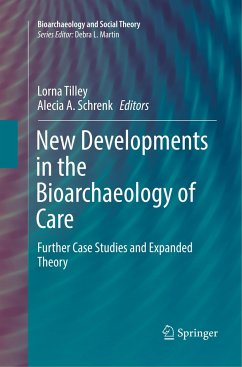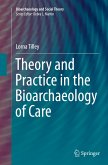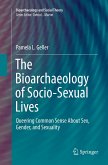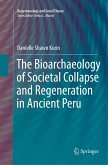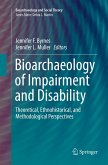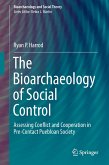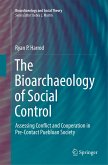New Developments in the Bioarchaeology of Care evaluates, refines and expands existing concepts and practices in the developing field of bioarchaeological research into health-related care provision in the past.
Evidence in human remains that indicates an individual survived with, or following, a serious pathology suggests this person most likely received some form of care from others. This observation was first made half a century ago, but it is only in the last five years that health-related caregiving has been accepted as a topic for bioarchaeology research. In this time, interest has grown exponentially. A focus on care provides a dynamic framework for examining the experiences of disease and disability in the past - at the level of the individual receiving care, and that of the community providing it. When caregiving can be identified in the archaeological record, bioarchaeologists may be able to offer unique insights into aspects of past lifeways.
This volumerepresents the work of an international, diverse, cross-disciplinary group of contributors, each bringing their own particular focus, style and expertise to analyzing past health-related care. Nineteen chapters offer content that ranges from an introduction to the basic 'bioarchaeology of care' approach, through original case studies of care provision, to new theoretical perspectives in this emerging area of scholarship. This book creates a synergy that challenges our thinking about past health-related care behaviors and about the implications of these behaviors for understanding the social environment in which they took place.
Evidence in human remains that indicates an individual survived with, or following, a serious pathology suggests this person most likely received some form of care from others. This observation was first made half a century ago, but it is only in the last five years that health-related caregiving has been accepted as a topic for bioarchaeology research. In this time, interest has grown exponentially. A focus on care provides a dynamic framework for examining the experiences of disease and disability in the past - at the level of the individual receiving care, and that of the community providing it. When caregiving can be identified in the archaeological record, bioarchaeologists may be able to offer unique insights into aspects of past lifeways.
This volumerepresents the work of an international, diverse, cross-disciplinary group of contributors, each bringing their own particular focus, style and expertise to analyzing past health-related care. Nineteen chapters offer content that ranges from an introduction to the basic 'bioarchaeology of care' approach, through original case studies of care provision, to new theoretical perspectives in this emerging area of scholarship. This book creates a synergy that challenges our thinking about past health-related care behaviors and about the implications of these behaviors for understanding the social environment in which they took place.
"The book is well structured and there is a good balance of case studies applying the approaches developed within the Bioarchaeology of Care. ... The book presents new research in the Bioarchaeology of Care ... . Not only does this book serve as a reference for the application of the Bioarchaeology of Care methodology but it also demonstrates that the discipline is in good shape." (Marta Díaz-Zorita Bonilla, European Journal of Archaeology, Vol. 23 (2), 2020)
"This edited volume demonstrates a maturing of the bioarchaeology of care paradigm, highlighting nuanced, careful theorizing and new avenues of exploration. ... these chapters demonstrate that when this perspective is applied cross-culturally, bioarchaeologists will bring a critical, self-reflexive approach to the analysis and interpretation of results, thereby deepening the intellectual rigor and the value of this paradigm. This edited volume claims a space for this approach in bioarchaeology, and it is awelcome addition to the literature on this topic." (Gwen Robbins Schug, Journal of Anthropological Research, Vol. 74 (3), 2018)
"Perhaps the most interesting bioarchaeological session to come out of a recent Society for American Archaeology conference symposium has now been published as an edited volume. ... the collection lays bare the methodology behind the case studies in a way that encourages other researchers to employ it as well. ... this volume represents an extremely successful collection of essays that should be on any archaeologist's bookshelf." (Kristina Killgrove, American Antiquity, Vol. 83 (2), 2018)
"I found this book to be a wonderful contribution to not only paleopathology, but the broader discipline of bioarchaeology and anthropology. It offers new depth to the bioarchaeology of care by providing diverse case studies ... . It examines case studies from across the globe and addresses groups that bioarchaeologists often find challenging. ... Tilley and A. Schrenk's volume is well-organized and effectively contributes to and expands on the bioarchaeology of care." (Carlina de la Cova, International Journal of Paleopathology, Vol. 17, 2017)
"This book, with its range of chapters, wealth of evidence and the Index of Care material, sits well beyond the obvious archaeological/biological readership ... . this is an important and timely addition to the literature on the individual in prehistoric and early historic societies. Many new approaches and techniques are being deployed to illuminate the human past through the remains of the actors themselves. ... Here is a volume that clearly documents the relevance of this approach to the past." (Beatrice Hale, Ageing & Society, Vol. 37, 2017)
"The 19 chapters cover topics including the explanation of the 'bioarchaeology of care' approach, case studies ofcare from different parts of the world and over time, and new theoretical developments in the field and the ethical dimensions of such research. ... will be required reading for any academic or postgraduate in the field." (Siân E. Halcrow, Antiquity, Vol. 91 (358), August, 2017)
"This edited volume demonstrates a maturing of the bioarchaeology of care paradigm, highlighting nuanced, careful theorizing and new avenues of exploration. ... these chapters demonstrate that when this perspective is applied cross-culturally, bioarchaeologists will bring a critical, self-reflexive approach to the analysis and interpretation of results, thereby deepening the intellectual rigor and the value of this paradigm. This edited volume claims a space for this approach in bioarchaeology, and it is awelcome addition to the literature on this topic." (Gwen Robbins Schug, Journal of Anthropological Research, Vol. 74 (3), 2018)
"Perhaps the most interesting bioarchaeological session to come out of a recent Society for American Archaeology conference symposium has now been published as an edited volume. ... the collection lays bare the methodology behind the case studies in a way that encourages other researchers to employ it as well. ... this volume represents an extremely successful collection of essays that should be on any archaeologist's bookshelf." (Kristina Killgrove, American Antiquity, Vol. 83 (2), 2018)
"I found this book to be a wonderful contribution to not only paleopathology, but the broader discipline of bioarchaeology and anthropology. It offers new depth to the bioarchaeology of care by providing diverse case studies ... . It examines case studies from across the globe and addresses groups that bioarchaeologists often find challenging. ... Tilley and A. Schrenk's volume is well-organized and effectively contributes to and expands on the bioarchaeology of care." (Carlina de la Cova, International Journal of Paleopathology, Vol. 17, 2017)
"This book, with its range of chapters, wealth of evidence and the Index of Care material, sits well beyond the obvious archaeological/biological readership ... . this is an important and timely addition to the literature on the individual in prehistoric and early historic societies. Many new approaches and techniques are being deployed to illuminate the human past through the remains of the actors themselves. ... Here is a volume that clearly documents the relevance of this approach to the past." (Beatrice Hale, Ageing & Society, Vol. 37, 2017)
"The 19 chapters cover topics including the explanation of the 'bioarchaeology of care' approach, case studies ofcare from different parts of the world and over time, and new theoretical developments in the field and the ethical dimensions of such research. ... will be required reading for any academic or postgraduate in the field." (Siân E. Halcrow, Antiquity, Vol. 91 (358), August, 2017)

